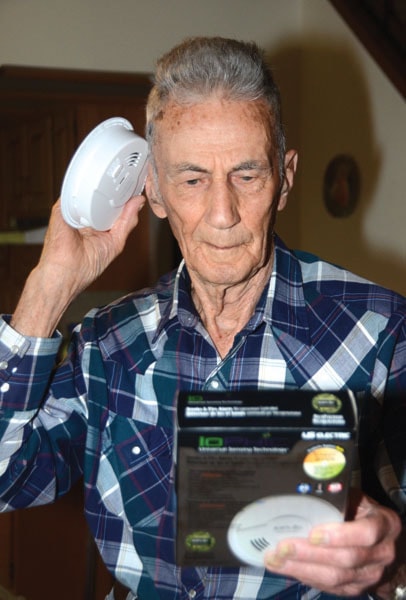The pan that was left simmering on the stove, unnoticed, is now glowing red and smoking. Suddenly it bursts into flames. The flames lick up the wall behind the stove and, in an instant, smoke and flames fill the kitchen.
A smoke alarm loudly blasts its warning but, upstairs in the bedroom, an occupant sleeps soundly. His hearing is impaired and he has no idea his life is in danger.
It’s the thought of this sort of scenario that drove Salmon Arm resident Chuck MacDonald to begin researching smoke alarms – and what’s available for people like him who can’t hear higher frequencies. MacDonald can’t hear a regular alarm, just like many others who have lost their high range of hearing through being exposed to machinery, music and other hearing hazards over the years.
“I’m one of the old guys who went through a noisy war as a kid,” he explains.
“It (the smoke alarm) would scream at you, and all I would hear is ‘beep, beep’ if I was sitting here like this.”
As far as he has discovered, there are no low-frequency smoke alarms available in Canada, only high frequency.
“There’s just a total lack of information, really. So many people have been affected over the years and just cannot hear them,” he notes.
At the Salmon Arm Fire Department, Fire Chief Brad Shirley is a director of the Fire Chief’s Association of British Columbia.
The association is currently undergoing a campaign to ensure every residence in B.C. has a working smoke alarm, or has smoke alarms that are tested regularly.
Dr. Joseph Clare, an employee of the Surrey Fire Department, wrote a report in January of this year on smoke alarms and fire prevention.
Questioned by Shirley about options for people who have difficulty hearing, Clare said alarms are being developed in Canada that produce a lower frequency tone. Alarms also exist that operate like bedside clocks.
“They look like clock radios and have speakers on the top. These alarms are designed to ‘hear’ smoke alarms going off (and operate through a number of doors). Once they detect this sound, they tone (or shout in English, ‘fire’), and also have an attachment that runs from the clock to under the sleeping person’s pillows. The attachment vibrates. The unit also strobes,” he wrote in an email.
Clare also noted there is a fire department on the east coast of the U.S. that is doing trials on the benefits of installing the bedside clock-type alarms in the bedrooms of elderly people in retirement communities.
President of the fire chiefs association, Len Garise, fire chief for the City of Surrey, told Shirley that the association is going to lobby industry to come up with better alarms.
Shirley points out that in Salmon Arm, in some apartments, seniors centres and townhouses, on each floor a fire warden is assigned whose duties are to knock on doors to ensure everyone is aware of an alarm and is evacuated. He adds that not having audible smoke alarms is a concern that fire chiefs share – and he appreciates the questions being asked.
At the Canadian Hearing Society in Ontario, JoAnn Bentley, director of the communication devices program, says everyone’s hearing loss is different, but many people suffer from the inability to hear high frequencies. She said she’s not aware if any low frequency alarms are available in Canada, but the society sells both a visual and a bed-shaking device. The first is a combination smoke and carbon monoxide detector that must be hard-wired. It produces a bright strobe.
Another is a smoke detector that can be hooked up to a device that shakes a person’s pillow.
One problem, Bentley says, is that the devices can be triple or quadruple the cost of regular smoke alarms, so often people will simply go without them.
“We’ve been lobbying to the government to find funding to help support the costs for these people,” she says.
A few Internet websites list smoke alarms for people who are hard of hearing, including low-frequency alarms, but they are all U.S.-based. Prices are higher than what a regular smoke detector would cost.
Meanwhile, MacDonald has been to numerous retail outlets and agencies in this region, and has found nothing available for a person who wants to buy a low-frequency smoke alarm.
He points out how quickly a fire can spread – and how crucial smoke alarms are to saving lives. He’s right, according to statistics.
A recent study of 50,000 residential fires in B.C., Alberta and Ontario over a five-year period – up to October 2011 – involving 663 fatalities showed that the death rate per 1,000 fires in the absence of a functioning smoke alarm was 74 per cent greater than when a functioning smoke alarm was present. That’s about 70 deaths per year that could be prevented.
MacDonald’s aim is to see low-frequency smoke alarms readily available at retail stores in Canada.
“I want to make people, businesses and older people aware of it,” he emphasizes.
When asked how he manages to protect himself now from fire at home, his serious look transforms into a grin.
“I have a wife.”
